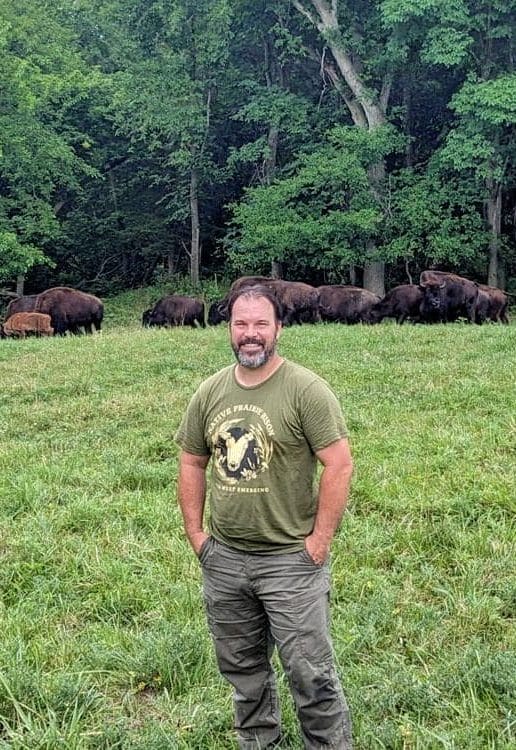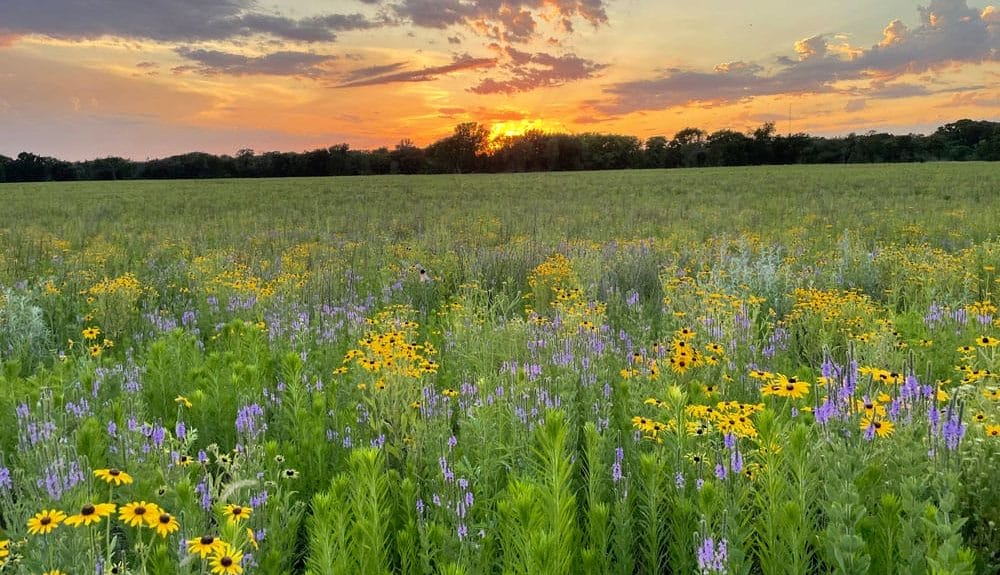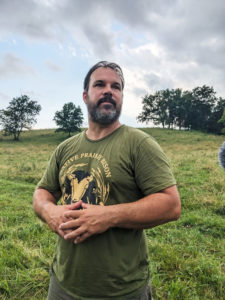Connecting Islands of Habitat
At Native Prairie Bison, Jathan Chicoine and Racheal Ruble are showing how farmers who add habitat can help create vital wildlife corridors in Iowa
Stepping onto Jathan Chicoine’s 180-acre farm just south of Story City, Iowa, feels like traveling back in time.
Windswept prairie grasses roll into mature oak savanna, their branches twisted high towards the sky. Tree-shaded ravines plunge steeply to meet Bear Creek, which meanders through the property. Peppered beneath the thick cover of oaks, a herd of bison takes refuge from the day’s rain.
But for Jathan and his wife, Racheal Ruble, this landscape is not merely a relic of the past. It’s their vision for a regenerative, interconnected future.
In 2011, Jathan returned to Iowa after 17 years away. During that time, he completed military service in the Navy, traveled the world and pursued his higher education. Now, returning home, he and Racheal wanted to continue being part of something bigger than themselves.
In 1993, Jathan’s father had purchased the original 67 acres of land Jathan and Racheal are now restoring. Envisioning their larger purpose, the couple told their family they wanted to raise bison and restore native habitat on the land. The family agreed, and in 2012, Jathan and Racheal brought bison from southeast Iowa, welcoming the herd with ceremony back to ancestral land the animals had been absent from for many decades.
Their farm, Native Prairie Bison, was born.
“We recognize the role that bison play in restoring native ecosystems,” Jathan says.
“Helping restore bison as a keystone species is at the heart of reclaiming the tallgrass prairie ecosystem.” -Jathan Chicoine
Wanting to graze their herd in its natural habitat, Jathan and Racheal got to work restoring native ecosystems. In 2013 they added 30 acres to the farm, and in 2014 Jathan and his family transitioned a pasture back to prairie, using seed from a local remnant prairie. In 2018, they purchased the original 67 acres from Jathan’s father, along with 28 additional acres.
In 2023, Jathan and Racheal used the federal Conservation Reserve Program to convert a 54-acre parcel back to native prairie. Most recently, Jathan is working on an oxbow and wetland restoration project along Bear Creek, which flows into the south branch of the Skunk River.
Their careful expansion and restoration efforts culminated in a big way. The farm’s newly restored habitat connects directly to the Skunk River Greenbelt – a 620-acre public area of woodlands, prairie, wetlands and riparian habitat stretching from Story City to Ames – creating one large, interlinked wildlife corridor.
The Need for Connection
These habitat corridors, which connect wildlife populations separated by human development and activities, are vital for species to thrive. In Iowa, where 99% of the state’s native habitat is gone, creating interconnected habitat is a pressing need – and a unique challenge. The prairie once covered 80% of the state, but now makes up less than 1%. More than 85% of Iowa’s land is farmed, much of it in monocultures of corn and soybeans. Cities, roads and other development further fragment Iowa’s already sparse habitat.
The result is an acute island effect where small pockets of habitat are isolated, making it harder for animals to move safely in search of food, mates and shelter. In Iowa’s heavily altered landscape, roadside ditches may serve as important corridors for some species. But they also have limitations. They may be too narrow for some species to functionally use, for instance. Habitat quality may be poor. They can also pose safety hazards if animals must cross roads to access other habitat areas, according to the U.S. Federal Highway Administration.
Various groups in Iowa are working to create more interconnected habitat. At the state level, the Iowa Department of Natural Resources’ wildlife action plan highlights areas across the state that are prime for creating bigger habitat zones, which the DNR calls “cores,” and wildlife corridors. But with so much agricultural land in Iowa, farmers and landowners like Jathan and Racheal are crucial to the effort.
“It’s been an absolute privilege to be able to see a return of native species that we have never seen here before,” Jathan says. “To see a bird making a nest with bison fur, something that was normal pre-European settlement, is being done again here on our farm.”
Jathan describes the many birds, insects and hundreds of types of prairie plants and flowers blooming on their land. These animals, he says, use the restored land as a resting point, and then use the farm stream that runs into the greenbelt as a safe passage.
Challenges and Opportunities

Jathan stands in front of his restored riparian corridor, a critical artery for wildlife. Bison graze in the background. Photo by Sara Diehn.
Even if farmers don’t have the same large-scale habitat goals as Jathan and Racheal, there are still many ways farmers can weave habitat into their own production goals. When several farmers in a local area add habitat, even smaller patches, they start to act as bigger interlinked corridors.
“Even small-scale endeavors can have a significant impact on restoring biodiversity and creating areas that wildlife can feel safe in and travel through,” Jathan says.
Brad Woodson, who recently served as PFI’s habitat viability manager, agrees. He suggests farmers take advantage of precision conservation, which pinpoints underperforming or marginal areas of their land that could be converted to habitat. Knowing those areas, farmers could add conservation practices like prairie strips and wetlands, which would benefit their farms while contributing to a potential wildlife corridor.
While Brad says some farmers worry about taking land from production, he notes that Iowa has a “built-in solution” for farmers who are hesitant about habitat.
“The state is full of rivers, streams and creeks. These are natural corridors that are often unsuitable for agriculture and are easiest for farmers to implement various habitat projects,” Brad says.
“Taking areas out of production that border waterways and installing habitat can go a long way to creating thousands of miles of natural corridor.” – Brad Woodson
“Often these farms are also more economically viable,” he adds, “because they are improving their soil and water quality as well, which makes for healthier land. But I think the biggest plus for habitat is the aesthetic value. You can’t really put a dollar figure on it.”
A variety of federal and state programs offer incentive payments for conservation practices that can help farmers and landowners concerned about profitability. The Conservation Stewardship Program and the Environmental Quality Incentives Program, both administered by the Natural Resources Conservation Service, are two such programs.

Prairie plants bloom on Jathan and Racheal’s farm, creating a wildlife corridor that connects to habitat on nearby public land. Photo by Jathan Chicoine.
Jathan and Racheal tapped into EQIP and were able to access a loan through the U.S. Department of Agriculture’s Farm Service Agency. They’ve also been working with the U.S. Fish and Wildlife Service and PFI on their oxbow and wetland restoration project. “We really couldn’t have gotten that start without those systems of support,” Jathan says. “Funding is often a barrier as many small farmers work off-farm jobs to pay for the farm.”
Once farmers have added habitat, they have to manage it to help it reach its full potential, or to sustain it over time. For Jathan and Racheal, controlling invasive species in their restored prairies has been a never-ending task.
Luckily, they get some help from their bison herd, which grazes some of those problem plants. They also like to rub against the invasive cedars. Over time, Jathan says this effectively girdles the cedars, lessening his maintenance load.
The restoration work at Native Prairie Bison has helped Jathan and his family deepen their connections to the land and the web of life intimately linked to it. But the connections also extend to the human community. They routinely host school groups and university students, who learn about Iowa’s native landscape while learning from Jathan and Racheal’s guiding philosophy of interdependence. Even the house on their farm where Jathan and his family now live flowed from their restoration work. Jathan says a neighbor who appreciated their efforts offered to sell the acreage.
“It was the focus on restoration of native ecosystems that created opportunities for us,” Jathan says. “Iowa was once the heart of the tallgrass prairie, and we want to leave our land in better condition for future generations.”

Bison roam in restored prairie on Jathan Chicoine and Rachel Ruble’s farm near Story City, Iowa. Photo by Jathan Chicoine.

